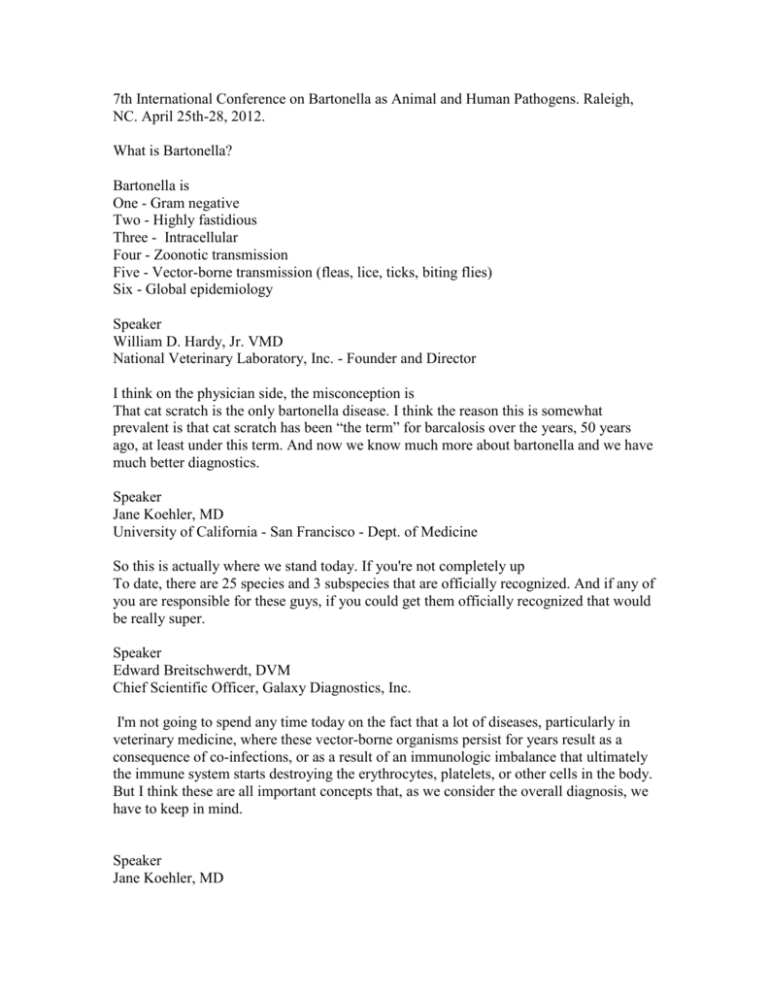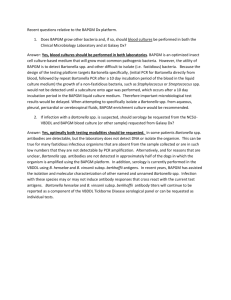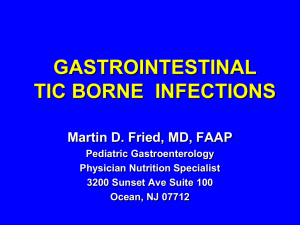7th International Conference on Bartonella as Animal and Human
advertisement

7th International Conference on Bartonella as Animal and Human Pathogens. Raleigh, NC. April 25th-28, 2012. What is Bartonella? Bartonella is One - Gram negative Two - Highly fastidious Three - Intracellular Four - Zoonotic transmission Five - Vector-borne transmission (fleas, lice, ticks, biting flies) Six - Global epidemiology Speaker William D. Hardy, Jr. VMD National Veterinary Laboratory, Inc. - Founder and Director I think on the physician side, the misconception is That cat scratch is the only bartonella disease. I think the reason this is somewhat prevalent is that cat scratch has been “the term” for barcalosis over the years, 50 years ago, at least under this term. And now we know much more about bartonella and we have much better diagnostics. Speaker Jane Koehler, MD University of California - San Francisco - Dept. of Medicine So this is actually where we stand today. If you're not completely up To date, there are 25 species and 3 subspecies that are officially recognized. And if any of you are responsible for these guys, if you could get them officially recognized that would be really super. Speaker Edward Breitschwerdt, DVM Chief Scientific Officer, Galaxy Diagnostics, Inc. I'm not going to spend any time today on the fact that a lot of diseases, particularly in veterinary medicine, where these vector-borne organisms persist for years result as a consequence of co-infections, or as a result of an immunologic imbalance that ultimately the immune system starts destroying the erythrocytes, platelets, or other cells in the body. But I think these are all important concepts that, as we consider the overall diagnosis, we have to keep in mind. Speaker Jane Koehler, MD So when you look at the clinical manifestations in humans, cats, and dogs. B. henselae and also b. hinsonii berkhoffii in dogs, I think you can see that there's some common themes. Lymphadinitus, athlerangimatosis in humans, and a couple cases in dogs, uveitis and ocular lesions very common in humans with cat scratch disease, seen occasionally in cats and dogs, and chronic bacteremia, it doesn't occur too much in humans, but cats of course can be infected for life. In terms of endocarditis, myocarditis, there is a predilection for bartonella species for cardiac tissue, and that's been well described in humans, especially for quintana, seen relatively less in cats, but seen in dogs. Prolonged fever, certainly in humans, and this occurs most frequently when humans are immune-compromised, and infected with a heterologous strain, not a human tropic strain. Lethargy, weight loss, anorexia, neurologic symptoms very common in people with cat scratch disease. Encephalitis is less common, but often seen. Arthritis and joint pain, glumerionephritis and reproductive disorders have been demonstrated by Bruno Chomel in cats. Why is Bartonella important? Important because One - Not on the radar of many medical practitioners Two - Persistent infection is easily confused with broad range of immunological disorders Three - Multiple means of transmission Four - Possible safety issues for transplant recipients, transfusions, and immune suppression Speaker Edward Breitschwerdt, DVM So my last slide, I just would like to conclude by saying that I consider bartonella the most important infectious isease problem for veterinary medicine. And I believe that because of a large number of vectors, a large number of reservoir hosts that are vectorcompetent, and because this is a self-packaging that is extremely difficult to detect in both animals and people. And again, many, many veterinarians sitting in this audience are very concerned about the overall impact of this information on the animals that we take care of in our profession. Second Jane Koehler, MD Why is bartonella such a problem? It's such a problem because It's so hard to diagnose, and it looks like a lot of other diseases. Speaker Michael Kosoy, Phd Division of Vector-Borne Infectious Disease, CDC Very short with round. Don't probably convince you to get upset at probably, bartonella indicarditis. It's probably the most severe form of bartonella infectious, and immunocompetent infections. Doctor Bransler tried to protect, bartonella saying that they're not so bad. They usually don't kill people. But the bartonella indicarditis does kill people and even in among this small group of limited group of patients, still we have some fatal cases. Speaker Paul Jawanda, MD University of North Carolina - Chapel Hill - School of Medicine And so I think it's sort of important to comment on the utility that based theories on both culture-negative endocarditis or because of the force of this, it makes the act of practicing [inaudible] disease physician considered [inaudible]. And we will always now put a question culture-negative endocarditis in addition. HOW IS BARTONELLA DETECTED? Detection One - All diagnostic tests have limitations Two - Serology is limited by lack of an antibody response Three - PCR plus BAPGM enrichment PCR are most sensitive Four - DNA sequencing for Bartonella species and strain identification assures 100 percent test specificity Speaker Edward Breitschwerdt, DVM In the context of bartonella in this slide, I think there's two things that are important diagnostically. One, if theoretically a patient sample that we process today had just one bartonella in it, tomorrow it'll have two, the next day it'll have four… and obviously most samples are not going to start out with one organism, but what has made this genius so difficult is this long dividing time. So fortunately, I think not being trained as a microbiologist, in conjunction with a post-op scientist, Dr. Sushama Sontakke we asked the question, if all the good bartonella researchers were finding that sheep keds, deer keds, sand flies, fleas, lice, and ultimately most recently ticks might be vector-competent for transmitting these organisms, would they be happier, And would they grow better in an insect biochemical composition, as compared to a mammalian growth media. And I think fortunately, the answer to that question was yes. So if we back up just a bit, I think it's important to acknowledge, regardless of the targeted organism, all infectious disease diagnostic tests have limitations. And it's clearly important for the clinician and the diagnostician to understand these limitations. So some of the limitations in general, whenever we're approaching -- in particular, as Jane showed yesterday, if you have an immune-compromised patient, most of the bartonellas are extracellular. I think in an immune-competent patient, we really don't know whether these bacteria are cellular, extracellular, or both at this point in time. Serology certainly should be done in my opinion in all patients in which we're contemplating a diagnosis, but as we all know, it doesn't confirm active infection. We'll talk about the fact that both in dogs and in people we are amazed at the number of infected individuals that are seral negative, and whether this is a manifestation of using the wrong antigens, or a manifestation that some individuals are actually energic and do not produce antibodies is yet to be determined. I don't think we're ever going to have an antigen test For bartonella, because I don't think it's ever going to be sensitive enough. And obviously, PCR demonstrates active infection, but what we've found is in and of itself, it is not always sensitive enough to detect in patient samples. So from that, once we figured out that this insect media might grow bartonella better and enhance our ability to find it in patient samples, Ashley Duncan, the Ph.D. student in the lab working with Ricardo Magi, described what we call the BAPGM platform. I would guess that this may be as complicated a diagnostic platform to confirm infection with an infectious agent that now exists, because from every sample we extract DNA, and for all human samples, as Doctor Mozayeni showed you yesterday, that includes independent PCRs from both blood and serum. Blood and serum are both incubated into BAPGM enrichment culture, and at 7 days 51 and 14 days DNA is extracted and the PCR is done. And at 7 and 14 days we subculture on an agar plate. And at that point, if something actually grows, a bartonellaspecific PCR is done. HOW IS BARTONELLA TREATED? Treatment is done by One - Antibiotics Two - Consider antibiotic resistance and enhancing immune function Three - Oral probiotics beneficial Four - Possible healthy carrier state Speaker Robert Mozayeni, MD Translational Medicine Group, Rockville MD So with [inaudible] antibiotic choices, most of you know this intracellular antibodies from [inaudible]. Geno [inaudible] for the time being has a toxicity and [inaudible], and we can't use it long-term. So, you know, I believe personally [inaudible] no role for [inaudible] therapy, and I don't even believe it's necessary going to be helpful, because there's even theoretical submersion in [inaudible] tissue, as well as being [inaudible]. As if [inaudible] are concerned, you know, in animals that the system develops very [inaudible], I've been using [inaudible] hand in hand, or [inaudible]. And the antibody [inaudible] is just an absolute must in managing these patients [inaudible]. [inaudible], just like there are [inaudible] physicians that are [inaudible] physicians, and it's important to evaluate [inaudible] enzymes for those aspirin [inaudible] issues. So far -- and I think there'll be more, but we have four well-documented cases of persistence after more than 6 months of [inaudible]. [inaudible] patient going to be fine, so I -- it takes a little work, but I convinced them that having bartonella and feeling well is an acceptable situation, and we don't have to be so obsessive that we get into trouble with ongoing antibody [inaudible]. So there is a thing, there is a healthy carrier state. But what we don't know is what the long-term [inaudible] are around some [inaudible]. If the [inaudible] were easier, faster, [inaudible], or safer, we could just treat these folks. But given how long and complicated courses of treatment are today, I think it doesn't make sense, if someone's healthy and [inaudible] to [inaudible] treatment, other than maybe some [inaudible] approaches. Produced by NC State University, College of Veterinary Medicine Continuing Education Sponsored by Galaxy Diagnostics www.galaxydx.com











